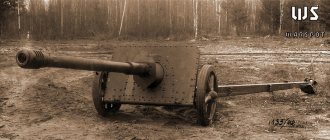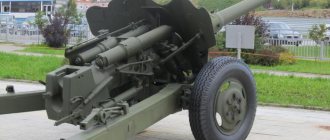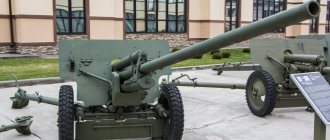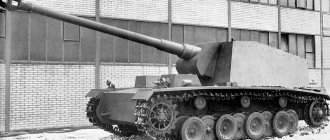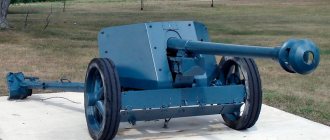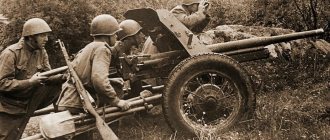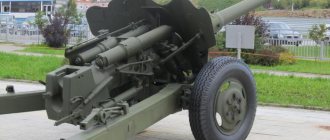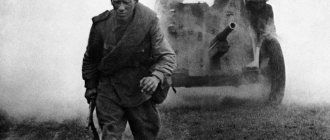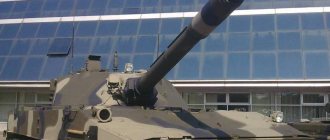Type of semi-automatic pistol
| Pistol Nambu Type 94 | |
| Pistol Type 94 | |
| Type | Semi-automatic pistol |
| Place of origin | Japan |
| Service history | |
| In service | 1935–1945 |
| Used | Japan |
| Wars | Second Sino-Japanese War World War II Chinese Civil War |
| Production history | |
| Designer | Kijiro Nambu |
| Developed | 1929 |
| Manufacturer | Nambu Rifle Company |
| Produced | 1935–1945 [1] |
| No built | 71 000 [2] |
| Characteristics | |
| Weight | 765 (1 lb 11 oz) [2] |
| Length | 187 mm (7.36 in) [2] |
| Barrel length | 96 mm (3.78 in) [2] |
| Height | 199 mm (4.69 in) [2] |
| Cartridge | 8×22 mm Nambu |
| Action | with reverse stroke, locking bolt |
| starting speed | 305 m/s (1000 ft/s) [3] |
| Feeding system | 6-round detachable box magazine [3] |
| Attractions | Front blade, rear fixed V [4] |
Type 94 Namba 8mm Pistol
(
Type 94 Pistol
, Japanese: 九四式拳銃Kyūyon-Shiki Kenjū) is a semi-automatic pistol developed by Kijiro Namba and his associates for the Imperial Japanese Army. Development of the Type 94 pistol began in 1929, and after several modifications, the final prototype was tested and officially adopted by the Japanese Army in late 1934 (Japanese calendar year 2594). [1] The Type 94 pistol entered production in 1935. About 71,000 pistols were produced before production ended in 1945.
The Type 94 pistol was developed by (and popular with) Japanese tank and aircraft crews who preferred a smaller, lighter design. Japanese weapons experts subsequently criticized certain elements of the Type 94's design; in particular, the pistol could inadvertently fire before the bolt was fully locked if the sear on the side of the receiver was loose and the pistol was mishandled. In addition, the process of disassembling the pistol is too complicated and inconvenient. The build quality of the Type 94 pistol declined over the course of its production; The 1945 "last ditch" pistols were crudely produced.
History[edit]
The Type 94 Nambu pistol was developed by Kijiro Nambu after he retired from the Japanese Army and founded the Nambu Rifle Manufacturing Company. [5] Development of the Type 94 Nambu pistol began in 1929 with the goal of reducing the bulk and cost of previous Nambu models. [3] The Imperial Japanese Army believed that a smaller, indigenously designed pistol that could accommodate the standard 8×22mm Nambu cartridge was needed to replace the larger, heavier, and only official military pistol, the Nambu (Type 14) pistol. [5] Demand for officer's pistols increased as a result of Japan's invasion of Manchuria during the Second Sino-Japanese War. [5] The Japanese Army also wanted the new design to include a magazine safety to prevent unintentional discharges during cleaning, which were common among Japanese personnel. [5] The name of the Type 94 pistol reflects changes in Japanese nomenclature, with 94 referring to the mythical founding of Japan in 660 BC, hence 2594 instead of the traditional reign of the emperor period used to designate the Type 26 or Type 14 revolver Nambu. gun . [6] The final Type 94 prototype was officially adopted by the Japanese Army in late 1934 after several modifications. [1] Production began under the supervision of the Nagoya Arsenal at Nambu Rifle Manufacturing Company and later at its successor, Chuo Kogyo Company, Ltd. [1] An estimated 71,000 pistols were produced for the military, but the exact number is unknown due to the production of non-production and undated pistols. [1] During World War II, the pistol became the weapon of choice for tank crews and paratroopers who needed a more convenient and compact pistol. [5] The Type 94 was never officially adopted by the Imperial Japanese Navy, but was available to officers through the Japanese Officers' Union. [1]
Design description[edit]
Hull and armor[edit]
The tank's hull had a riveted structure and was assembled on a frame made of backing sheets using rivets and bolts with bullet-resistant heads. The thickness of the armor plates varied between 8-12 mm.
The layout of the tank is with a front engine, the control compartment is combined with the combat compartment. The crew consisted of two people - the driver, located in the wheelhouse in the front part of the hull, to the right of the engine compartment, and the commander-gunner, located in the turret. The crew boarded and disembarked through a hatch in the rear of the vehicle. A manhole was made in the rear turret armor plate. For servicing the engine and transmission there were large hatches in the upper frontal plate with hinged (up) covers, for transmission repair there was a round hatch in the lower frontal plate with a bolted cover.
To the right of the power plant was the driver's seat. Due to the modest dimensions of the vehicle, a box-shaped armored cabin with three viewing slots and an upper hatch was made above the driver’s head. To the right of it, along the longitudinal axis of the body, a signal light was installed. In order to improve bullet resistance, the upper frontal sheet of the hull, which protected the MTO, was installed at a large angle of inclination.
Since the tank was supposed to be used according to the initial specification, there were towing hooks on the front and rear armor plates, and the rear one (on a semi-elliptical spring) was intended for towing a specially designed cargo tracked trailer or an armored canister trailer.
Weapons[edit]
The fighting compartment was designed only for the tank commander, who also served as a machine gunner. Landing was carried out through the aft door in the rear wall of the hull and a round hatch with a hinged lid. On the roof, offset to the left side, a conical turret with a bow niche was installed, intended for mounting weapons. The only armament of the tank was a machine gun located in the turret, mounted on a gimbal support with two axes of rotation, the ammunition load of which was 1,650 rounds. Since 1938, due to a change in rifle-machine gun caliber in the Japanese army, a 7.7 mm Type 97 machine gun was installed. Experiments were carried out with equipping the tank with coaxial machine guns, but due to the extremely small volume of the turret, they did not receive development. In addition, in the sides of the hull and turret there were openings that could be closed from the inside for firing from personal weapons. The turret was rotated using a shoulder rest.
Type 94 tank engine.
Engine and transmission[edit]
A 4-cylinder in-line carburetor Mitsubishi Type 94 air-cooled engine with a power of 32-35 hp was installed in the front part of the body on the left side. A fuel supply of 85 liters was located next to the engine. On the march, the average fuel consumption was about 8 liters per hour. Also, the cooling system fan was moved to the left side, drawing air through the radiator shutters on the left side. The exhaust pipe with a muffler was led back along the left side behind the blinds.
The mechanical transmission consisted of a main clutch, gearbox, differential and final drives.
Chassis[edit]
The chassis of the small tank used the original Hara type suspension. The support rollers were interlocked in twos on swinging balancers, which were suspended on the long arm of an L-shaped lever, the axis of which was mounted on the side of the hull. In turn, the short arm of the lever was hingedly connected to a horizontal rod leading to horizontal spiral springs enclosed in pipes riveted to the sides of the hull. The driving wheels of the lantern gear were located at the front, the guide wheels at the rear. The small track consisted of steel tracks 160 mm wide. The upper caterpillar branch was supported by two rollers on each side. Spare parts boxes were attached to the fenders.
Design[edit]
Type 94 pistol from the Hong Kong History Museum.
The Type 94 pistol is powered by a different mechanism than previous Japanese pistols. [7] Unlike previously developed Nambu pistols, the Type 94 operates with a hidden hammer and firing pin rather than a hammer. [1] According to the authors, Harry L. Derby and James D. Brown, the firing pin is inherently weak and prone to failure due to the notch cut provided for the cross stopper and is prone to failure at that point. [1] A stronger firing pin was developed and included in the Type 94 to replace the poor firing pin on the Type 14 Nambu. [6] The locking system is a lifting block that floats independently between lugs under the chamber end of the barrel. [7]The single-coil mainspring is located around the barrel rather than at the rear of the barrel as on other Nambu pistols. [7] The grip is smaller than other Japanese pistols and finished in smooth wood, [8] but according to author Jeff Kinard, is more comfortable for use by men with smaller hands. [9] The magazine holds a maximum of six rounds due to the smaller grip [6] and is considered difficult to reload the weapon with pressure from the bolt holding it inside the pistol. [1] The magazine release protrudes far enough to occasionally disengage when the pistol is placed left side down on a hard surface. [1]The magazine could also come free if it was pinched or jammed in the holster. [1] The manual safety lever is located on the left rear of the frame, and the frame has the kanji for fire and safe stamped into it. [1] The front sight on the muzzle of the Type 94 pistol and the rear fixed V-shaped sight were sometimes positioned incorrectly, rendering them useless when aiming the weapon. [4] The rear sight was reduced from a U-shape to a simple notch in 1944, with the front blade remaining unchanged, but less attention to detail was paid as World War II progressed. [10]
Final production[edit]
The quality of Type 94 Nambu pistols declined towards the end of World War II as the Japanese faced Allied bombing and material shortages. [11] This is a dramatic change in quality from the end of March 1945, with all quality standards disappearing by the end of June 1945. [12] The smooth wooden handle was replaced with a bakelite checkered pattern. [8] Many pistols were not mass produced, and no pistols dated July 1945 have been reported. [12] Only four unserialized and undated pistols are known to exist, which include mismatched parts without reference marks, lanyard loops, and extractors. [13] A small number of pistols produced in the final stages of production have earlier production dates and appear to have been salvaged from previously discarded pistols that had minor or cosmetic defects. [13]
Excerpt characterizing Nambu Type 94
“I’m listening,” answered Dron. Yakov Alpatych did not insist any more. He had ruled the people for a long time and knew that the main way to get people to obey was to not show them any doubt that they might disobey. Having obtained from Dron the obedient “I listen with,” Yakov Alpatych was satisfied with this, although he not only doubted, but was almost sure that the carts would not be delivered without the help of a military team. And indeed, by evening the carts were not assembled. In the village at the tavern there was again a meeting, and at the meeting it was necessary to drive the horses into the forest and not give out the carts. Without saying anything about this to the princess, Alpatych ordered his own luggage to be packed from those who had come from Bald Mountains and to prepare these horses for the princess’s carriages, and he himself went to the authorities. X After her father’s funeral, Princess Marya locked herself in her room and did not let anyone in. A girl came to the door to say that Alpatych had come to ask for orders to leave. (This was even before Alpatych’s conversation with Dron.) Princess Marya rose from the sofa on which she was lying and said through the closed door that she would never go anywhere and asked to be left alone. The windows of the room in which Princess Marya lay were facing west. She lay on the sofa facing the wall and, fingering the buttons on the leather pillow, saw only this pillow, and her vague thoughts were focused on one thing: she was thinking about the irreversibility of death and about that spiritual abomination of hers, which she had not known until now and which showed up during her father’s illness. She wanted, but did not dare to pray, did not dare, in the state of mind in which she was, to turn to God. She lay in this position for a long time. The sun set on the other side of the house and slanting evening rays through the open windows illuminated the room and part of the morocco pillow that Princess Marya was looking at. Her train of thought suddenly stopped. She unconsciously stood up, straightened her hair, stood up and went to the window, involuntarily inhaling the coolness of a clear but windy evening. “Yes, now it’s convenient for you to admire in the evening! He’s already gone, and no one will bother you,” she said to herself, and, sinking into a chair, she fell head first on the windowsill. Someone called her in a gentle and quiet voice from the side of the garden and kissed her on the head. She looked back. It was M lle Bourienne, in a black dress and pleres. She quietly approached Princess Marya, kissed her with a sigh and immediately began to cry. Princess Marya looked back at her. All previous clashes with her, jealousy towards her, were remembered by Princess Marya; I also remembered how he had recently changed towards m lle Bourienne, could not see her, and, therefore, how unfair were the reproaches that Princess Marya made to her in her soul. “And should I, who wanted his death, condemn anyone? - she thought. Princess Marya vividly imagined the position of m lle Bourienne, who had recently been distant from her society, but at the same time dependent on her and living in someone else’s house. And she felt sorry for her. She looked at her meekly questioningly and extended her hand. M lle Bourienne immediately began to cry, began to kiss her hand and talk about the grief that befell the princess, making herself a participant in this grief. She said that the only consolation in her grief was that the princess allowed her to share it with her. She said that all former misunderstandings should be destroyed before great grief, that she felt pure in front of everyone and that from there he could see her love and gratitude. The princess listened to her, not understanding her words, but occasionally looking at her and listening to the sounds of her voice.
Disassembly[edit]
Disassembling the Type 94 Nambu pistol is considered difficult and can lead to damage to the pistol if handled carelessly. [2] After clearing the Type 94, the operator must press the bolt against the magazine follower to keep the bolt in the rear of the pistol. [2] This will release the cross bolt once the hammer is pressed. [2] Removing the cross bolt without depressing the firing pin will damage both the firing pin and the cross bolt. [14] Removing the crossbar is further complicated by the dismantler's hands holding the gun and pressing down on the firing pin. [14]
Diagram showing sear placement that can become loose and cause misfire
Holster[edit]
Type 94 pistol holsters were typically made of pigskin or cowhide and ranged in color from brown to dark reddish brown. [15] The holsters suffered the same deterioration in quality as the Type 94 pistol. [15] As Japan's leather supply was exhausted, holsters manufactured in 1944 were made from olive drab fabric. [15] The Type 94 pistol holster differs from other Japanese holsters with a pointed closing flap and a vertical magazine pouch. [16] The bag has a narrow extension to accommodate the cleaning rod. [15] Most holsters were made in civilian-owned tanneries, with some inked with armory and inspection marks.[17] A belt loop and two D-rings for the shoulder strap are provided on the back of the holster and are available in brass, galvanized steel or nickel plating. [15]
Unintentional dismissal[edit]
Poor bolt design allowed the Type 94 Nambu to fire unintentionally. [3] The sear on the Type 94 Nambu converts a straight trigger pull into a lateral movement that releases the hammer. [18] Because the sear is on the outside of the pistol, [18] it could become loose during firing if the pistol was cocked and handled carelessly. [6] The front end of the sear must be depressed approximately 2mm for the weapon to fire. [5] The ability to fire the Type 94 without pulling the trigger gave rise to war stories of Japanese soldiers surrendering only to fire the gun, earning nicknames such as the "suicide special" and the "surrender gun".[ 5] These stories are widely discredited due to the difficulty of firing the weapon while gripping the sear. [5] If the safety is engaged on the Type 94, the weapon cannot fire unintentionally. [1]
Gallery[edit]
- Small tanks Type 94 on the march.
- Small tank Type 94 of the amphibious assault force. The tank commander poses in full gear.
- A short stop during a joint march with the infantry.
- American tank crews hoisted a Japanese Type 94 small tank onto the stern of their M4A2 medium tank, probably Kwajalein Island, March 1944.
- Japanese light tank Type 94 "TK", captured during the battles of July 2–4, 1939. The commander of the Red Army is standing on the tank.
- Type 94 small tank training with infantry, Manchuria, late 1930s.
- Small tanks Type 94 (manufactured in 1936) at a collection point for captured equipment, late 1945.
- Small tank Type 94 destroyed during the battle for Kwajelein Atoll, February 1944.
- Small tank Type 94 model 1937 captured by American troops, 1945.
Notes[edit]
- ^ abcdefghijklm Derby, Harry L. Japanese Military Cartridge Pistols 1893–1945
(2003), p. 191 - ^ abcdefgh Derby, Harry L. Japanese Military Cartridge Pistols 1893–1945
(2003), p. 193 - ^ abcd Hogg, Ian, 20th Century Military Small Arms
, 7th edition, (2000) p. 67 - ^ ab Miller, David. Fighters Uniforms, Equipment and Weapons of the Axis Forces of World War II
(2010), p. 277 - ^ abcdefgh Derby, Harry L. Japanese Military Cartridge Pistols 1893–1945
(2003), p. 189 - ^ abcd Hogg, Ian, Pistols of the World
, 4th edition, (2004) p. 234 - ^ abc Skennerton, Ian, Handbook of Japanese Service Pistols
(2008), p. 22 - ^ ab Skennerton, Ian, Handbook of Japanese Service Pistols
(2008), p. 16 - Kinard, Jeff. Pistols: An Illustrated History of Their Impact
(2003), p. 247 - Derby, Harry L. Japanese Military Cartridge Pistols 1893–1945
(2003), p. 207 - Derby, Harry L. Japanese Military Cartridge Pistols 1893–1945
(2003), p. 219 - ^ ab Derby, Harry L. Japanese Military Cartridge Pistols 1893–1945
(2003), p. 220 - ^ ab Derby, Harry L. Japanese Military Cartridge Pistols 1893–1945
(2003), p. 221 - ^ ab Derby, Harry L. Japanese Military Cartridge Pistols 1893–1945
(2003), p. 194 - ^ abcde Derby, Harry L. Japanese Military Cartridge Pistols 1893–1945
(2003), p. 225 - Derby, Harry L. Japanese Military Cartridge Pistols 1893–1945
(2003), p. 224 - Derby, Harry L. Japanese Military Cartridge Pistols 1893–1945
(2003), p. 226 - ^ ab Skennerton, Ian, Handbook of Japanese Service Pistols
(2008), p. 23
Links[edit]
- Cooks, Alvin D. (1985). Nomonhan: Japan vs. Russia, 1939 (in two volumes)
. Stanford University Press. ISBN 0-8047-1160-7. - Foss, Christopher (2003a). The Great Book of Tanks: The World's Most Important Tanks from World War I to the Present
. Zenit Press. ISBN 0-7603-1475-6. - Foss, Christopher (2003b). Tanks: 500. Crestline. ISBN 0-7603-1500-0.
- Tomczyk, Andrzej (2002). Japanese Armor Vol.
1 . AJ Press. ISBN 83-7237-097-4. - Zaloga, Stephen J. (2007). Japanese tanks 1939–45
. Osprey. ISBN 978-1-8460-3091-8.

